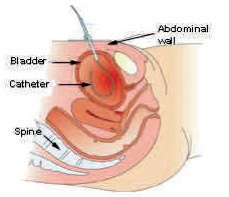Download and print as a PDF (312kB pdf)
On this page
What is a suprapubic catheter?
A suprapubic catheter is a plastic tube that is passed through the lower part of the abdomen (tummy) into the bladder to drain urine outside.
Why do I need a suprapubic catheter?
This is required to drain the bladder when passing a catheter through the urethra is either unacceptable or unsuitable. This can be for a short period but more often it is a long term for long term conditions.
Examples for these conditions include:
- Patients who are unable to pass urine themselves, either because of nerve and / or muscle disease
- Patients with dementia who can not recognise the need to pass urine

How is the insertion carried out?
Insertion is often carried out on the ward under local anaesthesia, but occasionally it might require general anaesthesia. The procedure will be explained by the doctor.
You will be made comfortable and covered. The area will be cleaned. Local anaesthesia will be injected. A small cut is made in the lower part of your tummy, just above the hairline. If you had a previous operation, the incision will be through the scar and ultrasound guidance may be needed to avoid bowel injury.
The catheter will be passed through this cut using a special inserting device. Your bladder may have to be filled with saline prior to insertion, to ensure easy localisation and access.
Sometimes, it may be necessary to have a look into your bladder with a camera (cystoscopy) at the same time. The catheter may be fixed with sutures and a drainage bag will be attached and usually strapped to your thigh.
What are the risks?
There are risks with any operation but these are small. The main risks associated with the insertion of a suprapubic catheter are:
Common risks:
- Blood stained urine: this is caused by passing the catheter into the bladder and usually settles within days
- Pain, which is managed by pain killers
Uncommon risks
- Urinary tract infection: this may happen as a result of passing the catheter into the bladder and is treated with antibiotics
- Wound infection: this is treated with antibiotics
In order for you to make an informed choice about your surgery please ask one of the doctors or nurses if you have any questions about the operation before signing the consent form.
What can I expect after the operation?
You will be observed for a while to ensure the bladder is draining properly and you do not have any problems. You can go home after that. The catheter will need to be changed if it stops drainage.
What about follow up?
The catheter will be removed when the need for its insertion ends. Otherwise, the catheter may need to be replaced every few months. This can be done at the hospital or by your doctor.
Who can I contact with any concerns or questions?
If you have any problems or questions, please use the contact numbers below to speak to a urogynaecological team.
Princess Royal Hospital
01444 441881
Ext. 5686
Royal Sussex County Hospital
01273 696955
Ext. 4013
Urogynaecology Unit at Lewes Victoria Hospital
01273 474153
Ext. 2178
Useful links:
Drugs.com: How to care for your suprapubic catheter
Bladder and Bowel Community: Suprapubic Catheter
This patient information leaflet was prepared by Dr. Sharif Ismail, Consultant Subspecialist Urogynaecologist.
This information leaflet has been approved at the Clinical Governance and Safety and Quality Meetings of the Department of Obstetrics and Gynaecology as well as Brighton and Sussex University Hospitals NHS Trust Carer and Patient Information Group (CPIG).
This information is intended for patients receiving care in Brighton & Hove or Haywards Heath.
The information in this leaflet is for guidance purposes only and is in no way intended to replace professional clinical advice by a qualified practitioner.